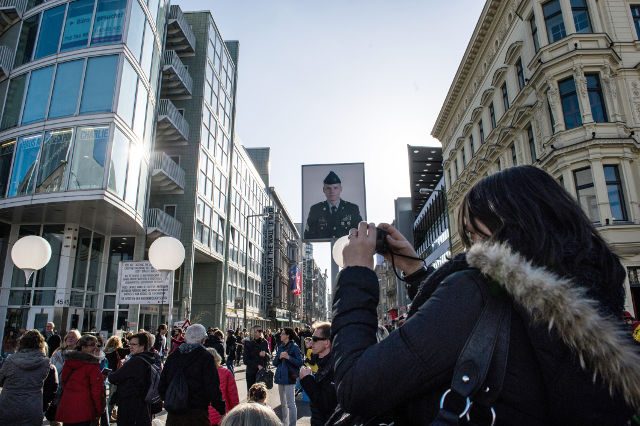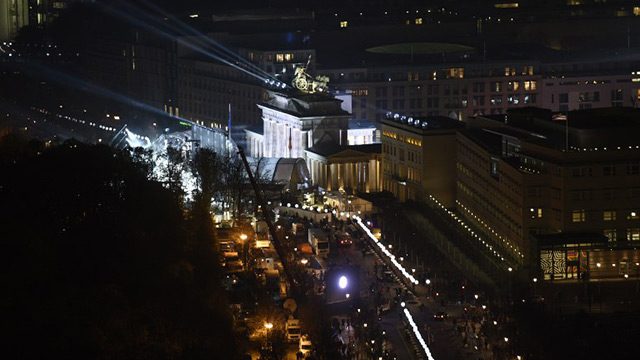SUMMARY
This is AI generated summarization, which may have errors. For context, always refer to the full article.

BERLIN, Germany – Hundreds of thousands of people descended on the German capital Saturday, November 8, for festivities to mark the fall of the Berlin Wall 25 years ago, stirring emotions and bringing memories flooding back of its joyous toppling.
Under chilly but sunny skies, people streamed between key points of the Wall’s former path where information boards recount the monumental events of November 9, 1989 when a peaceful revolution led to the border’s opening after 28 years.
Germany would reunite within the year, on October 3, 1990.
Germans and foreign visitors posed for photos in front of graffiti-daubed remnants of the Wall or admired some of the 7,000 gently swaying white balloons pegged to the ground in a light installation winding 15 kilometers (9 miles) along the Wall’s route.
Others watched onstage preparations at the iconic Brandenburg Gate, resplendent against the blue sky, where children rehearsed and rock stars and freedom icons will join a massive open-air party in Sunday’s culmination of the festivities.
At Potsdamer Platz, once cleaved in two by the detested Berlin Wall and now a bustling junction with shiny modern tower blocks, a small crowd watched East German demonstrators in video images chant: “We are the people!”
“I cried. It was so dramatic,” Italian tourist Juliane Pellegrini, 60, a school headmistress from South Tyrol, recalled, saying she had followed events on television the fateful night the Wall came down.
Twenty-five years later in the city where it took place, she said she felt emotional all over again. “It’s the history of central Europe,” she told the Agence France-Presse.

‘So unlikely’
Similarly Hungarian Andras Marton, 43, was visiting Berlin especially for the Wall’s anniversary.
He first came to East Berlin aged 15 and has returned to the city several times this year for business and pleasure. “I started to learn, read about the Wall. I bought books,” he said, adding he could “share some of the feeling” after growing up behind the Iron Curtain.
Chancellor Angela Merkel, who grew up in communist East Germany, said in her weekly podcast Saturday that the reunified capital of Berlin had become “almost a symbol of Europe’s unification after the Cold War”.
She also praised its significance as a tourist magnet and said the importance of tourism for Germany, a branch in which, she said, 2.9 million people were employed, could not be under underestimated.
Last year 70 million people visited Europe’s top economy from abroad, she added.
Business was likely to be brisk for sausage and beer sellers on the avenue beside Berlin’s Tiergarten park, its autumnal trees providing a picturesque forefront to the prominent cupola of the Reichstag parliament building.
The festivities are being held under the banner “Courage for Freedom” and participants include the last Soviet leader, Mikhail Gorbachev, whose “perestroika” and “glasnost” reforms helped pave the way for the Wall’s fall after 28 years.
Merkel was due on Saturday to attend a memorial concert at Bertolt Brecht’s historic Berliner Ensemble theatre and, on Sunday, she will open a major exhibition on Bernauer Strasse, a street divided by the Wall.
Gorbachev and former Polish president and freedom icon Lech Walesa, 71, are among those due on Sunday at the Brandenburg Gate, the symbol of German unity, for entertainment to include rock music and fireworks.
Thrown up in 1961, the Wall stretched 155 kilometers (96 miles) but today only around 3 kilometers of it still stands.
Manfred and Edna Tschepe, both 72, said they went to bed at their home in West Berlin on the night of November 9, 1989 before hearing the momentous news.
“Unfortunately we slept through it,” Manfred, a retired engineer said, chuckling.
But when he emerged from the underground train station the next morning on to Berlin’s upscale Kurfuerstendamm avenue, it was packed with people, many of them Easterners looking in amazement into the shop windows, he said.
On hearing the Wall had gone, he thought “that can’t be. It was so unlikely. I can’t believe it.” – Rappler.com
Add a comment
How does this make you feel?
There are no comments yet. Add your comment to start the conversation.